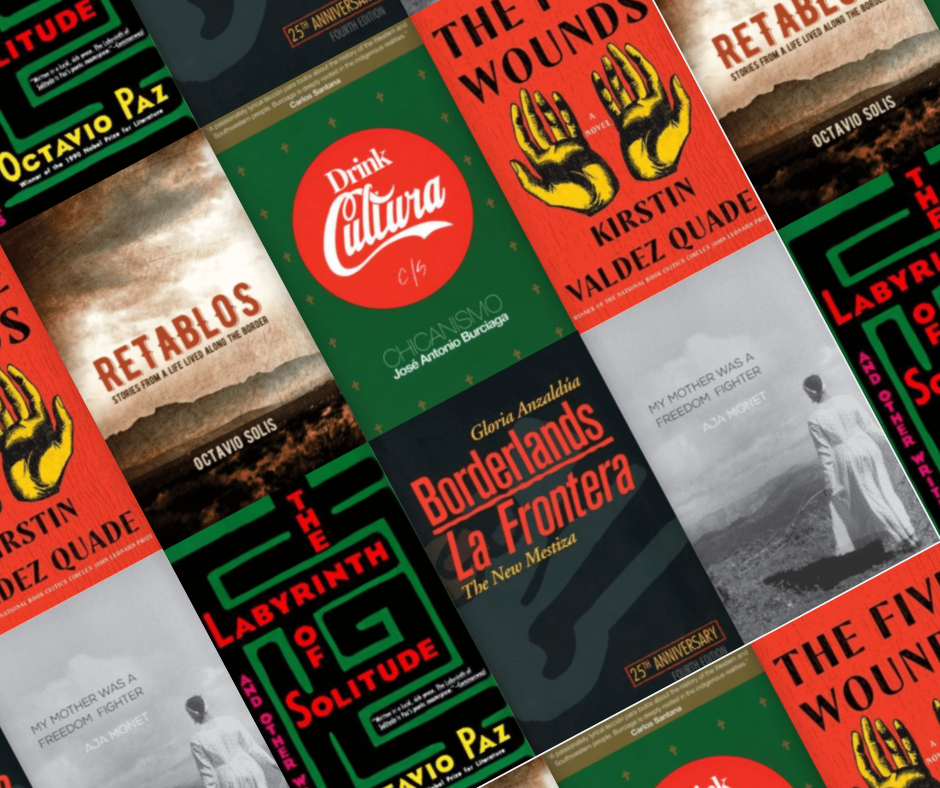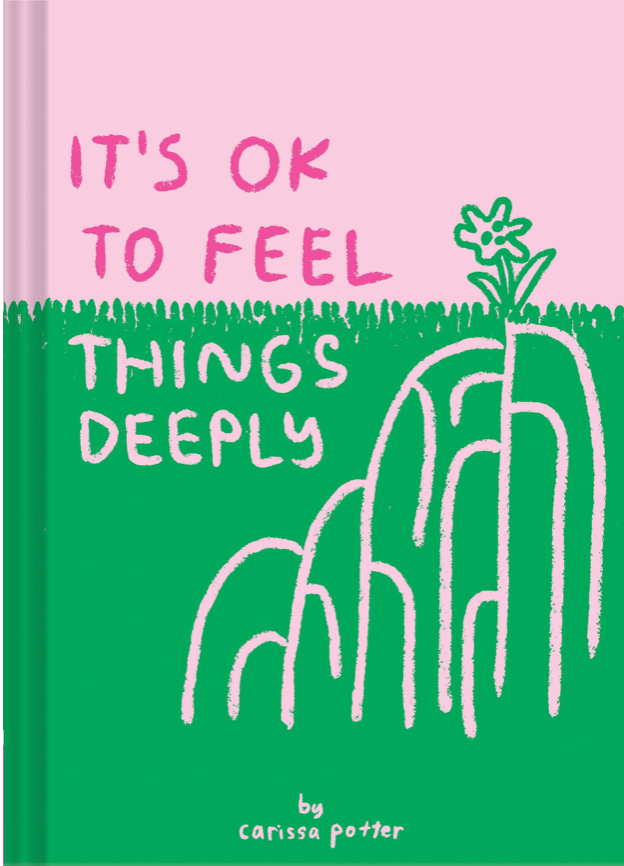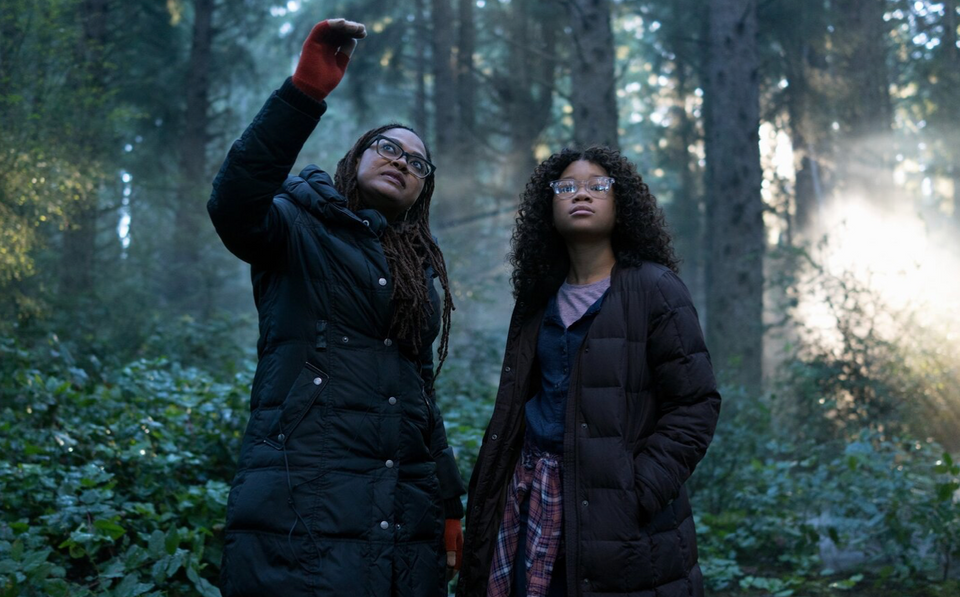The Mysterious Benedict Society, published in 2007, is the first in a series of children’s books by Trenton Lee Stewart that’s being made into a television show of the same name, premiering Friday, June 25 on Disney+. Starring Tony Hale, Kristen Schaal, MaameYaa Boafo, and a handful of young actors, the comic adventure follows four extraordinarily gifted children enlisted by the titular Mr. Benedict to save the world from the plans of his evil twin brother, Mr. Curtain, who runs a boarding school that’s a front for a media operation that uses secret messages to promulgate unease about the Emergency—a state of ongoing anxiety that may seem familiar to anyone alive in the 21st Century.
Phil Hay created the show with his writing partner, Matt Manfredi. Together they have written several movies, including the Ride Along franchise, Crazy/Beautiful, Clash of the Titans, and, with Hay’s wife the director Karyn Kusama, Aeon Flux, The Invitation, and Destroyer. I spoke with Hay over Zoom, and our digressive, sprawling conversation touched on adaptation, how children know more about what’s going on than they’re given credit for, and the pleasures of collecting baseball cards. The following conversation has been edited for clarity and concision.
The Curator: How did you and Matt get involved with The Mysterious Benedict Society?
Phil Hay: I had seen the book in my son’s school library. Our producers sent it to our agent, who knows we usually write features and haven’t done a lot of television, but who told us, “There’s something special about this book. I think you guys would get it.”
I would imagine when you’re adapting Harry Potter you feel extremely—not in a negative way per se—tied to the literal events of those novels because, I mean, Harry Potter. Fans would not be excited about a massive digression from what’s a canonical series. Benedict has tons of fans and is well-loved, but the feeling we got was that every single little thing didn’t have to be the same in the show and the book. The important thing was that the book’s characters and relationships were honored.
An example of a change that does this, I think, is that the first book is centered on the kid characters. The adults pretty much disappear from the novel after the first part. We realized that wouldn’t work for a television series, at least not the one we wanted to do. So we invented a side-by-side plot for the adults that kept them in contact with the kids, kept them developing as their own selves. That allowed us to take a side tour to territory that hadn’t been explored with these characters.
Visually, we wanted to give the show a Jacques Tati feel—a mid-century, European utopianism, a little bit Wes Anderson. People might imagine the book’s world as Victorian or gothic, the wonderful illustrations [by Carson Ellis] bring you that, but we wanted a different visual language, which would in turn help us understand how this world works—like the fact that there are electric cars, but no internet. There’s solar power, but no cell phones. It’s a world that’s evolved slightly differently than ours.
Though the book came out in 2007, there are recurring themes in it that feel rooted perhaps in the experience people who grew up amid and after things like 9/11, the 2009 crash, the pandemic, and so on. We see in the book the invisibility of the labor class, the “helpers,” who are basically indentured servants. There’s the constant emergency amplified by conspiracy thinking. Outside of the book, we encounter feedback loops in electronic media that make us anxious. We might not know why, just as many in the book can’t trace the source of their own agitation. The book almost quotes Orwell in some of the messages being explicitly taught to the children in the school, like “war is peace” and “it’s important to protect yourself because you cannot protect yourself.” This makes the thoughtful, responsible students feel a little crazy. How do you approach bringing themes from one medium to another?
Every writer has a different relationship to how they approach theme—from extremely intellectual to extremely intuitive, from being very forward to refusing to talk about it. We like to articulate themes to ourselves and then let that express itself in the story. Having articulated themes gives the characters something to talk about. Conversations start to organize themselves.
The theme that got us, as parents, is that this period we’ve been living in for a while is like a wave, an epidemic, of anxiety. This makes the book incredibly au courant. Take the idea of someone producing a state of anxiety that is nameless. We asked, “How does that benefit anyone? Why is this state of anxiety being created?” The answer we came to is that people who are constantly anxious are disempowered, they’re easy to manipulate and control.
The book describes the desire to control others by hammering them with messages that, whatever degree of truth and falsity they have in them, are designed to create confusion, designed to make it so that nothing is true—you know, that doublespeak thing where you encounter something and then just say, “I don’t believe it,” and then you don’t have to believe it anymore. “I don’t believe in science.” Well, science isn’t really something to believe in or not. It just is. Yet you can say, “I don’t buy it.” This displacement expressed in the book we connected to our current era. Many of us have the experience of waking up every morning and looking into the magic little window of anxiety and depression to get our day started and feeling utterly out of control, angry and disempowered. One of my favorite classic plots is the mind-control plot. It felt appropriate that the villain’s aim is mind control by strangely realistic means.
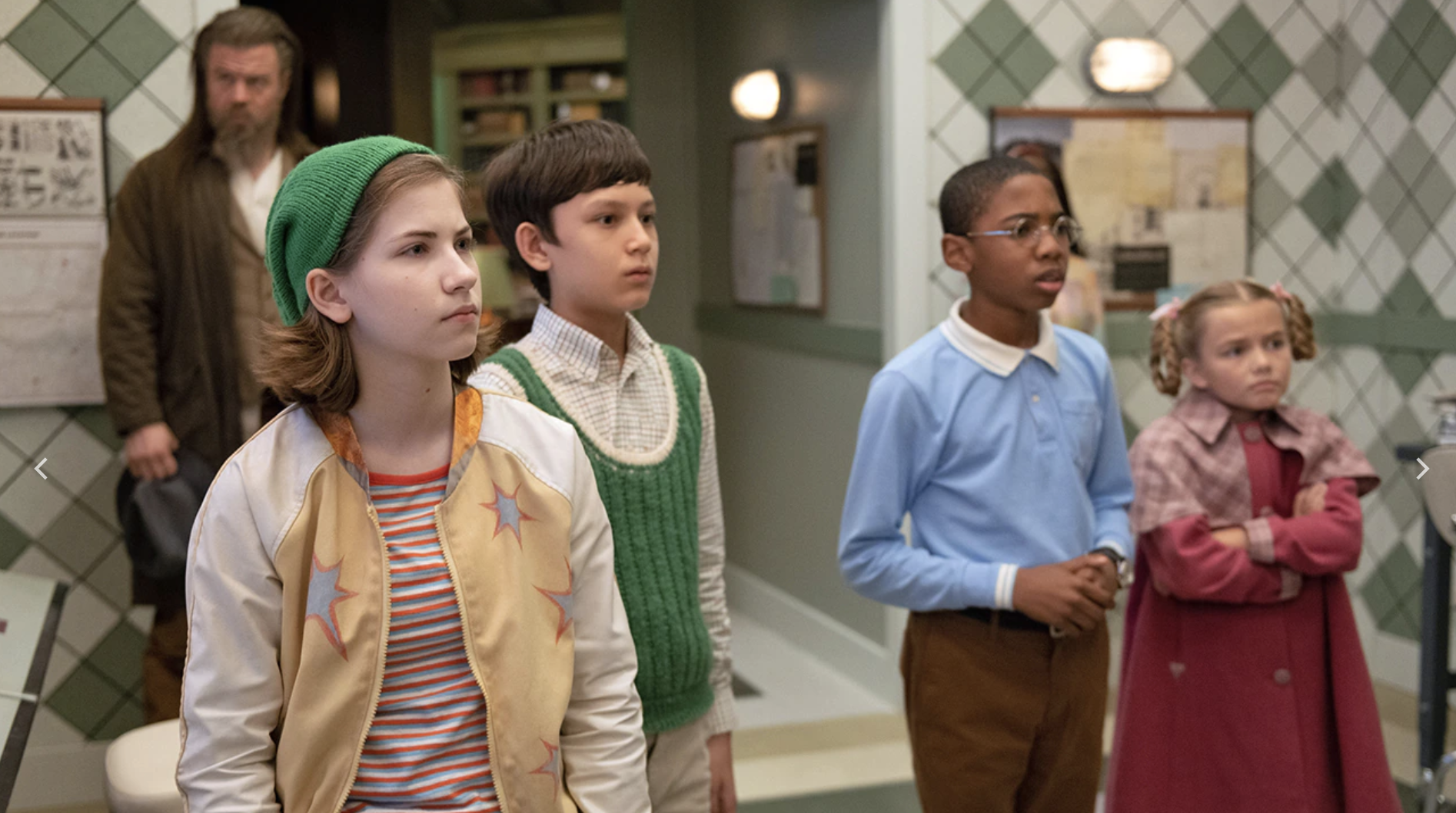
In our world, the black box of the algorithm amplifies feelings that unsettle us, and so many of the political expressions of the past five years seem to be a physical manifestation of an invisible force, like the anger-slime under New York in Ghostbusters 2. Yet part of the reason we watch TV shows is to ease our anxiety, to temporarily forget about the conflicts of the “real world.” How do you strike a balance between entertainment and what might be called “thematic relevance”?
I hope people say the show is funny, that it’s complicated, that it’s got a lot of ideas and characters you truly care about. The villain is actually pretty funny, convinced of his own correctness, and the supporting villains are also very funny. It’s taking place in a world that’s not about brutality, the way a lot of television shows are. Yes, it’s making a connection, but not too grim a connection, to the world of today.
I think kids respond to having the truth reflected back to them. Every kid I encounter—my son, his friends, the kids I coach in baseball—they all know what’s going on. In the show feelings of tumult and upset and something’s-wrong-and-I-can’t-quite-say-what-it-is are addressed in what I hope are useful and entertaining ways. We’re trying to pull apart what it means to be propagandized, to be indoctrinated, to be given phrases to repeat that when you stop and think about them don’t actually add up.
I would never have predicted that the most practically useful course in college I had taken was semiotics. The study of language and signs and signifiers and what lies beneath and inside those constructions is actually the most relevant tool for living that I can think of right now. My Lacan and my Derrida and all that stuff is coming out in the show—quietly, but it’s there.
How has your craft as a writer, as a collaborative writer, deepened and changed over time? And what has working on this particular project taught you?
Well, Matt and I have taught each other how to write in this medium. We’re different people with different concerns in some ways, but we also have an idea of what’s supposed to happen that feels mysterious—why certain things have to connect, why certain transitions have to happen. It feels intuitive. The challenge of that intuitive approach is that, whether you’re just turning in drafts to the studio or network, or to actors or people who have questions, or when collaborating with other writers in the writers’ room—the challenge is that we don’t want to explain why we’re doing a thing. It’s like explaining why a joke is funny. You could say, “Because in the western tradition normally authority is to be made fun of, but in this case, we’ve turned it and now authority is actual authority and that’s why it’s surprising.” That never works. People sometimes think audiences want complete clarity every minute, with everything explained, but in my experience people actually do like mystery or weirdness or oddness. When you approach writing a poem, you don’t approach it thinking you’ll have to explain it to somebody, right?
No. Flannery O’Connor once gave a speech and described a letter she got from a student asking about the meaning of “A Good Man is Hard to Find.” O’Connor says, and I’m paraphrasing, “I suspect this person had a paper to write.” She says this kind of question suggests that the meaning is separable from the story. But for O’Connor the story is the meaning. The mode is the disclosure. That doesn’t mean you don’t think of the audience. You’re adapting a children’s novel, so you’re not going to do something at odds with that. The book has a surreal and whimsical approach to storytelling, and you’re not going to violate that.
That’s right.
So you aim to be true to the book’s spirit.
Yes.
I’ll give this example. I teach a class with art and writing students who have to make collaborative objects. When an object and its meaning are unitary, or univocal, there’s no space between what it means and what it is, so there’s no space for the audience to participate in making or interpreting it. I’m always disappointed when I read a mystery and feel like, when it’s over, “I never have to read that again.” It answered every question and solved every problem. I like when the resolution is rich in its ambiguity—fruitful ambiguity is what a poetry professor of mine said years ago. There’s space for the audience to feel they aren’t being shut out…
…or pandered to. You have to create space for fun and imagination. When I was growing up Star Wars was my fun imaginative world. What is on that movie screen is Star Wars, but offscreen you can still explore it. Sitting with my toy Millennium Falcon and all my figures, I could remix good guys and bad guys. I could make new stories. That invitation comes from a consistent tone that makes sense, a way of looking at human interaction and behavior.
My hope for our show is that it’s not just reducible to the necessary story points for getting from here to there. There are digressions, but they’re not random. They’re part of a plan to embrace audiences who will love that weird side character or the fact we’re spending an unconventional amount of time on a character’s journey through the educational system. The joy of this process has been meeting minds with writing collaborators and directors, Karyn [Kusama] being one of them, and with actors. We would say, repeatedly, We want this to be one of the weirdest shows you’ve ever worked on, one of the most uncanny, and if we make it funny enough we can get away with it.

At The Curator, we like to think in terms of the cultural artifact—book, album, art installation, movie—and to think of these artifacts as sites revealing emotional, social, political, and spiritual forces. If you were to think of the show as a crafted object you can hold in your hand, how would you describe it? What are its properties, its weight, its shape? How does it reflect the light?
These questions get at something a lot of people might not understand about the physical qualities of making television and movies. Writing a script is an extremely tactile experience. I have a piece of paper and I’m scratching outlines and I’m writing notes on it. Eventually, you’ll see take after take of the actors doing the script. You cut it together, you work on the cut, refine it in the mix. All this is like the feeling of sticking your hands in a bunch of sand and pulling out different things, like, “Oh there’s that Hot Wheels car I lost. Let’s dust it off. That’s pretty good! What else is down there?” You’re turning out something physical, working with all these incredible craftspeople who pour their artisanal expertise into the finished product.
We felt the show should feel analog and homemade, in some way, and very heart forward. The colors carry a Technicolor vibe. The look is not loose and shaky, not headlong and crazy. It has energy and lightness, with gravity underneath. If I picture Destroyer or The Invitation as objects, they feel very different in my hand than this show does, which feels like wood, like a nice, well-sanded piece of wood where you can feel the essence in there, and life. This show is much more wood than metal, but it’s got a little glass in it, too, warm glass.
To talk more about the show as artifact is interesting because I’m really connected to artifacts. I try to keep something physical from each of the productions we’ve done. I have, as an example, one of the thousands of little resin sculptures of people made for lining the walls of Olympus in Clash of the Titans. For this show the book itself is the artifact. My copy is bowed out because there are so many dog ears and so much writing in it. I feel the weight of it. If I were to lose it, I could replace it with a fresh copy that looked the same, but this copy of the book is the show. It’s me.
I have no idea what kind of music Trenton was thinking of when he wrote this, but in the show, it’s all music I would hear in my mom and dad’s car, AM radio. We decided people in this world listen to popular, positive music that has a little hint of humor, like ELO and Maxine Nightingale. What this music means to me and what it means to others, in their individual experiences, becomes part of the show’s meaning.
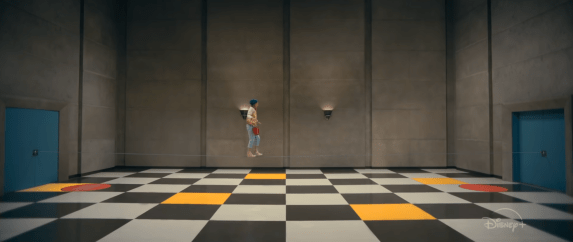
I watched the trailer and saw scenes I recognized from the book. It put me in mind of the filmmaking. A shot is composed, staged, and lit and might show up in the finished product for mere seconds. You’ll get this whole crew of people to paint and arrange a set so that they can show someone hopping over…
…the checkerboard…
…the checkerboard floor. It’s lovely and touching, frankly, what people will do to tell a story.
That’s part of the magic. I don’t remember why it came up but we decided that in this world, people just love water polo, and tetherball, and nobody’s ever heard of football or basketball. Trenton didn’t write about sports. I think his book accommodates a world where water polo is the most popular sport. It isn’t motocross. I can’t explain why. In one episode, we see the dorm room of one of our characters. She’s a jock, so she should have posters on her wall, like the posters we had of our favorite baseball players. I created an entire league of professional water polo teams. I thought this character would be a fan of the Fairbanks Midnight Suns. We also invented commentators calling a tetherball match: “The Finns, very strong, are playing the Bulgarians, whose program has fallen on hard times.” All that thought and discussion results in little background details most people probably won’t notice. If they do, it will, hopefully, please them to know someone tried to work out the corners of this world.
It’s a way of caring for the material.
Over the course of the pandemic, I re-entered the world of collecting baseball cards, a massive part of my childhood that just disappeared for decades. I returned to it because of my son, but it was also me. The artifactness of collecting baseball cards, the physicality of it, pulling all those old cards out of the closet and opening boxes that have not been open for 40 years in some cases—it’s amazing: the smell of the cards, reading them. Since my childhood the baseball card community has exploded. You can have your cards graded: How centered are they? Is there damage? Is there surface damage or are the corners dog-eared? If you take a card out of the pack and it seems like it could increase in value you become careful. Back then, as a kid I’m like, “Hey look at this Gary Carter rookie card.” Then I’d just throw it in the box and pick it out and look at it again without cleaning the peanut butter off my hands. Those marks made the cards special, too.
Because so much is now virtual and digital, you can almost fetishize physical artifacts, removing them from human interaction by enshrining them.
Right. To have a baseball card graded, you send it away to professional graders. They then ultrasonically seal it, entomb it in plastic, so it can’t be then made “worse,” or degraded, by your handling it. If it’s graded a 10, it’s a gem, it’s perfect. Part of me wants to actually hold it of itself, to feel the different textures—like, this card stock is different from that card stock. This glossy surface is fun to look at under the light.
My nephew plays sax and clarinet and is just really into music. I bought him a turntable and some records. All the music he needs, more than he can ever listen to, is in this little device [holding up an iPhone], but he has since talked to me about how listening to a record is a different experience. There’s a ritual. It’s concentrated, there’s no shuffle. There’s the artwork. I don’t want him to become—well, he can if he wants to be—an obsessive audiophile. I want him to just be happy experiencing something in a different way that feels invested.
To me the Golden Age of TV was when everything was out on DVD or Blu-ray, because even though it’s still technologically advanced, you could hold the thing, you could kind of understand it: here’s the thing in a package. Maybe it’s my age talking, but every time I open up a screen and am asked for a password, I expect nothing to happen. I’ll lose what I’m looking for. I’m not the first to say this, but you could listen to records even if there was no electricity. You could turn a crank and out of the big horn on the gramophone, you could hear the music. It’s the same with a book or poem. You can hold it. You don’t need anything else. You don’t need the satellites and the technology and everything to work for you to have that thing. I believe the satellites are great, but I don’t want to put my whole existence in the hands of the satellites.


